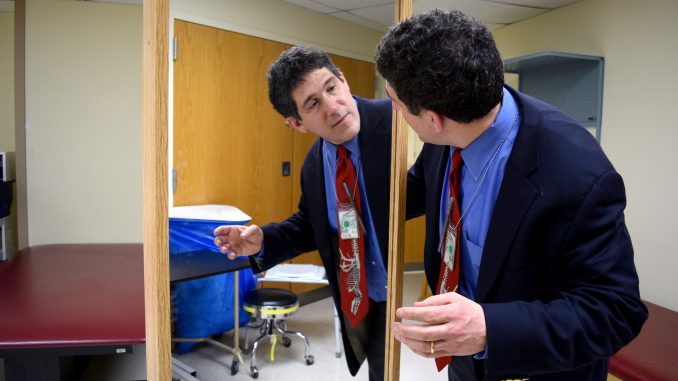
Many amputees suffer from “phantom pain,” psychologically experiencing pain in the limb that is no longer physically there. Eric Altschuler, an associate professor of the department of physical medicine and rehabilitation at Temple University Hospital, uses an object found in most household bathrooms to treat amputees and stroke patients.
Since TUH hired Altschuler in 2014, the hospital has practiced mirror therapy, a rehabilitative method to alleviate phantom limb pain.
“People think it’s not going to work,” Altschuler said. “But if they have a phantom limb and it’s moving poorly, and [mirror therapy] works, they’re happy. But not everything works for everybody.”
The term “phantom limb” was coined by Silas Weir Mitchell in 1872 to refer to a sensation which can affect some amputees after the procedure. Even though the limb has been removed, many patients still experience burning, cramping or crushing pain.
Altschuler’s professor, Vilayanur S. Ramachandran at the University of California developed mirror treatment in a study published in 1996.
A patient receiving mirror therapy places their functioning limb on one side of a mirror, and their affected limb on opposite sides of the mirror. The patient then looks at the reflection of their intact limb, which creates the illusion the phantom limb has been revived. If the patient sends motor commands to both sides while looking into the mirror, the patient gets the visual impression that their phantom limb is “executing” its command.
About 185,000 amputations occur every year in the United States, according to amputee-coalition.org, and about 80 percent of all amputees still experience pain in their phantom limb, according to the National Limb Loss Center. Half of all patients suffer the pain 24 hours after the amputation, according to the U.S. National Library of Medicine. This phenomenon can lead some patients to experience depression and suffer suicidal thoughts.
“It’s definitely positive because you can avoid to add more medication,” said Ernesto Cruz, a professor of physical medicine and rehabilitation at TUH. “Adding medication causes more harm than good and mirror therapy shows it can help.”
Altschuler and Cruz also believe mirror therapy is cheaper than prescribing more medication to patients.
Altschuler was the first to be published for mirror therapy being used on stroke patients in The Lancet in 1999. He then received a grant from the American Academy of Physical Medicine and Rehabilitation to further his studies with mirror therapy on soldiers who are returning home from war.
“It’s a study to see if there’s any other patients it might help,” Altschuler said. “The question Ramachandran and I ask ourselves is, ‘Can we advance the treatment, and offer more than they had on July 3, 1863?’ Our goal is to offer more than they did on that day.”
Tom Ignudo can be reached at thomas.ignudo@temple.edu.


Be the first to comment